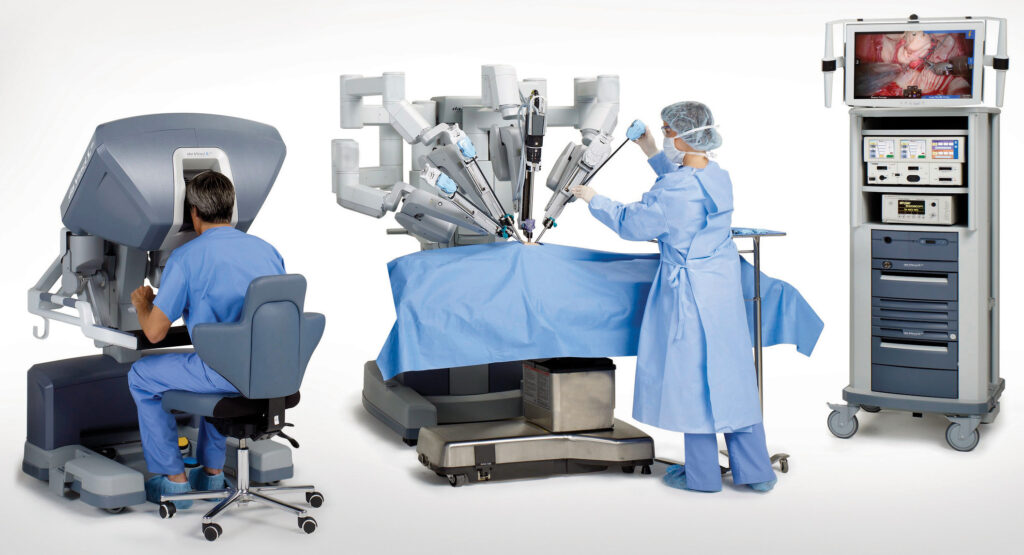
Introduction-
Minimally invasive knee replacement procedures have revolutionized the field of orthopedic surgery, offering patients faster recovery times, reduced pain and improved outcomes. Among the advancements in this field, robotics has emerged as a game-changing technology. In this blog, we will explore the role of robotics in minimally invasive knee replacement procedures, highlighting its benefits and potential impact on patients and surgeons alike.
Understanding Minimally Invasive Knee Replacement-
Before delving into the role of robotics, it’s essential to grasp the concept of minimally invasive knee replacement. This procedure involves smaller incisions, specialized instruments and advanced techniques that enable surgeons to replace damaged knee joints with prosthetic implants. The primary goal is to restore function, relieve pain and enhance the patient’s quality of life.
Introduction to Robotic-Assisted Knee Replacement-
Robotic-assisted knee replacement takes the concept of minimally invasive surgery to a new level. Robotic-Assisted Knee Replacement is an innovative surgical technique that combines the expertise of surgeons with the precision of robotic technology. It involves using a robotic system to create a virtual 3D model of the patient’s knee, enabling accurate implant placement and alignment. This advanced approach improves surgical outcomes and enhances patient recovery.
Integration of Robotic Technology in the Procedure-
- Preoperative Planning: Before the surgery, the surgeon uses advanced imaging techniques, such as CT scans or MRI, to obtain a detailed image of the patient’s knee joint. This data is then fed into the robotic system.
- Virtual 3D Modelling: Using the collected imaging data, the robotic system creates a virtual 3D model of the patient’s knee joint. This model serves as a guide for the surgeon during the procedure.
- Surgical Mapping: The surgeon works closely with the robotic system to plan the precise positioning and alignment of the prosthetic components. The system provides real-time feedback, helping the surgeon make informed decisions.
- Robotic Guidance: During the surgery, the robotic system assists the surgeon in executing the pre-planned surgical strategy. It provides visual and auditory cues, allowing the surgeon to accurately position and align the implants.
- Continuous Monitoring: Throughout the procedure, the robotic system continuously monitors and adjusts the surgical movements. It ensures optimal precision and assists the surgeon in maintaining the planned alignment and balance.
- Data-driven Assistance: The robotic system captures and analyses data during the surgery, providing valuable insights to the surgical team. This information can be used for postoperative evaluation and improvement of future procedures.
Overview of the Robotic System Utilized in Knee Replacement Surgeries-
The robotic system used in knee replacement surgeries consists of advanced technology that combines imaging, navigation and robotics. It includes specialized software and hardware components, such as robotic arms and sensors, to assist surgeons in planning and executing precise implant positioning and alignment for optimal surgical outcomes.
Benefits of Robotic-Assisted Knee Replacement-
The integration of robotics brings numerous benefits to the field of knee replacement surgery. These include:
- Enhanced Precision: The integration of robotic technology allows for precise planning and execution of the procedure, resulting in more accurate implant positioning and alignment.
- Personalized Approach: The virtual 3D model generated by the robotic system enables a tailored surgical plan, accommodating the unique anatomy and condition of each patient.
- Reduced Complications: The improved accuracy and precision of robotic-assisted surgery can lead to a decrease in complications, such as implant loosening or misalignment.
- Faster Recovery: The combination of minimally invasive techniques and robotic assistance promotes quicker recovery times, reduced pain, and shorter hospital stays for patients.
- Improved Visualization: The robotic system provides high-definition imaging, enhancing the surgeon’s view of the surgical site and enabling better decision-making during the procedure.
- Surgical Assistance: Robotic technology acts as a valuable assistant to the surgeon, enhancing their skills and capabilities while reducing physical strain.
- Real-time Feedback: The robotic system provides continuous feedback on the surgical process, ensuring optimal precision and guiding the surgeon throughout the procedure.
In summary, robotics has transformed the landscape of minimally invasive knee replacement procedures, offering numerous advantages to both patients and surgeons. By integrating advanced technology, such as preoperative planning, virtual 3D modelling, surgical mapping, robotic guidance, continuous monitoring and data-driven assistance, robotic-assisted knee replacement ensures enhanced precision, personalized surgical approach, reduced complications, faster recovery, improved visualization and valuable surgical assistance. The seamless collaboration between surgeons and robotic systems leads to improved surgical outcomes and patient satisfaction. As technology continues to advance, the future of knee replacement surgeries looks promising, with robotics playing a vital role in revolutionizing the field.
For more information and to consult with an expert in knee replacement surgeries, you can visit the website of Dr Saurabh Giri at https://www.kneereplacementsurgeonpune.com/. Dr Giri is a renowned orthopedic surgeon specializing in knee replacements and can provide comprehensive guidance and support for individuals seeking effective and advanced treatment options.




